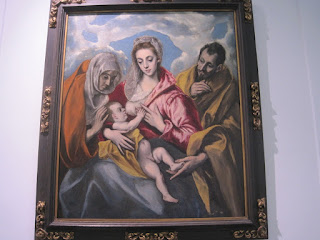It was time to keep moving so we travelled by bus to Almeria
to board the train bound for Madrid.
Unfortunately Michael wasn’t very well so it was bad timing that we had
a 6 hour train journey ahead of us. The
time passed slowly for Michael and he was grateful when we finally arrived at
our destination. Fortunately he awoke
the following day feeling much refreshed and we were able to continue our
journey to Toledo, a 35 minute train ride away.
We arrived at the beautiful railway station in Toledo, which
opened in 1920 and was designed in the neo Mudejar style. The station has been classified as a monument
and was fully restored in 2005. Michael
promised that it was only a short walk to our hotel however he neglected to
tell me that the entire walk would entail dragging my suitcase over
cobblestones up a steep incline. We
arrived, panting, some 45 minutes later and I was not amused to discover that
it would have only cost 4.50 Euro to travel by taxi. We deposited our bags at the hotel and set
off to discover the city.
The reason that we added Toledo to our itinerary is that
Michael’s mother, Anne, gave us a Val McDermid book, Killing the Shadows, which
was about a series of murders in Toledo.
The book described a wonderful city and mentioned that there were a
number of paintings by El Greco there.
This, in turn, inspired our visit.
We decided to follow the El Greco trail through the town,
starting with the Iglesia de Santo Tome, a lovely church, with the huge
painting The Burial of the Count of Orgaz.
This painting is considered amongst El Greco’s finest works and
illustrates a popular local legend of his time.
At the time the very pious count died, St Stephen and St Augustine
descended in person from the heavens and buried him by their own hands. The painting is quite beautiful and lavish in
detail.
The next stop was the El Greco Museum. The museum consists of two buildings, one is
a 16th century house, which recreates the home of El Greco and the
other is a modern building which houses the artworks. There are not many El Greco paintings there
however there are lots of works by his followers displayed.
The Primate Cathedral of Saint Mary of Toledo is considered
to be one of the best Gothic cathedrals in Spain. The building is huge and ornately decorated
and the Chapterhouse is beautiful with a lovely frieze running all around the
room adorned with portraits of all the archbishops. The Chapel of the Treasure holds the great
Monstrance of Arfe which stands over ten feet tall and is made of the finest
silver and gold and bejewelled with gems.
The Disrobing of Christ, by El Greco, is also on display at the sacristy
of the cathedral. This is one of El
Greco’s most famous works and it was thrilling to see this beautiful piece.
We continued the El Greco trail the next morning, finding
our way to the Hospital de Tavera just outside the walls of Toledo. Here we saw two versions of the Baptism of
Christ as well as exploring the wonderful old church. However, the highlight was seeing the Risen
Christ, the only surviving sculpture by El Greco. It is only a small work (45 cm) however it is
mesmerising in its beauty.
The trail continued with a visit to the Museum of Santa
Cruz, which was filled with ceramics and artworks as well as a number of works
by El Greco, including Sagrada Familia con Santa Ana. The Renaissance building itself is beautiful
and the works are displayed to their full effect.
Toledo is a magical old city and we spent hours wandering
the laneways up and down the hills. The
food was terrific and we enjoyed sampling tapas in a number of bars and
restaurants. We were there on a public
holiday and it was obvious that it is a very popular destination for Spanish
people as the crowds poured into the streets.
The next day, when everyone returned to work, the streets were much
quieter with only a handful of tourists strolling about. I would love to return as Toledo was by far
my favourite place we visited in Spain.










No comments:
Post a Comment